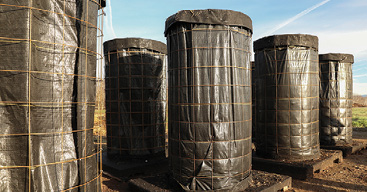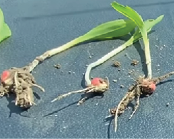
“You just can’t grow good corn without fertilizer – and the more fertilizer, the more corn!” If you are a corn farmer, odds are that is a thought that has been drilled into your brain so deeply that it almost seems like heresy to question the statement. We have all seen where there has been a skip in fertilizer application and the corn is pale and stunted. It is absolutely true that we need fertilizer, nitrogen in particular, to grow good corn crops in the soils and management system that is in place across the vast majority of our nation’s farmed fields. But what if the soils and the management were different? Could we change our soils so that they supplied the nitrogen and other nutrients to our crops without the need for applications of synthetic fertilizer?
That was a hypothesis that Jay Young, with Young Red Angus of Tribune, KS set out to test with experimental strips in his irrigated corn field. On the first test strip, he applied the fertilizer his agronomy consultant called for, which was 180 pounds per acre of actual nitrogen and 40 pounds of phosphate. On a second strip, he applied no fertilizer at all, but rather 8 gal/acre of a compost extract made from 2 pounds of compost produced by the Johnson-Su method, which creates a compost with a high population of fungi. On a third strip, he applied 90 pounds of nitrogen, no phosphate, and 8 gallons of Johnson-Su compost extract.

Corn with N applied had more seeding growth but less root development.

Corn seedlings with only compost extract had less above ground growth early but tremendous root system development. The soil sticking to the roots is a sign of high soil microbial activity.
The results? When the combine rolled, the full fertility treatment produced 238 bushels per acre, while the no fertilizer treatment yielded a lower but surprisingly respectable 200 bushels per acre. At current corn and fertilizer prices, the full fertilizer treatment was more profitable. But the real surprise was the treatment with a half rate of nitrogen and compost extract combined, which yielded a very impressive 242 bushels an acre and blew the other two treatments away in terms of profitability.
The whole idea of a compost extract replacing fertilizer might seem like promoting fairy dust and whiffle powder to some, but there is an emerging science behind the idea. The Johnson-Su process is a compost method in which there are aeration tubes placed in the pile and the pile is left to sit undisturbed for as long as a year, as opposed to the normal compost method in which the pile is vigorously stirred to aerate it. The lack of disturbance and slow, cool decay, results in a compost that is very high in fungal activity. Most agricultural soils are very low in fungi, due to their long history of tillage, which tears fungal hyphae apart. Fungi are a major driver of desirable soil structure and aggregation. And when soil structure improves to a sufficient extent that the soil aggregates begin to reach a minimum diameter of 10 mm (about 3/8 of an inch) something curious begins to happen. It has long been known that there are free-living nitrogen fixing bacteria (like Azotobacter and Azospirillum) in the soil, but it was always assumed that their activity was so minor that they did not really contribute much to soil fertility. But all those observations were in tilled soil largely devoid of good soil aggregation. Why is this important? Most of these free-living nitrogen fixing bacteria require an unusual combination of conditions in which to thrive: first, they need a copious amount of carbon root exudates for an energy source, and secondly they need anaerobic (lacking oxygen) soil. This at first seems contradictory. Roots need aerobic soils full of oxygen to grow and produce exudates. So where exactly could these two conditions both occur? As it turns out, it happens inside of large diameter aggregates with a high level of microbial activity that uses up the oxygen as it diffuses from the outside of these large aggregates towards the center, creating an anaerobic core where these bacteria can live but also be in close proximity to roots that produce their energy giving exudates. These free-living nitrogen fixers require conditions which we have not seen in most agricultural soils until recently: a lack of tillage, a constant flow of root exudates, and a high fungal population. How much nitrogen can they produce? We honestly don’t really know. But we do know that given the right conditions they can contribute a lot more than we used to think. Dr. Richard Mulvaney and Dr. Saeed Kahn of the University of Illinois are currently researching this very phenomenon, and we hope to be able to report on their finding in a future SHRG!
For more information on these topics, check out these resources
Jay Young Video: 200 bu Corn with No Nitrogen
Green Cover Webinar featuring Dr. David Johnson and Hui-Chun Su: Biologically Enhanced Agricultural Management with Dr. David Johnson & Hui-Chun Su
Green Cover Webinar featuring Dr. Richard Mulvaney and Dr. Saeed Kahn: Escaping the Futility of Nitrogen and Potassium Fertility with Dr. Richard Mulvaney & Dr. Saeed Kahn
This article first appeared in the 8th Edition of Green Cover's Soil Health Resource Guide.
Also check out the 10th edition, our latest Soil Health Resource Guide, over 90 pages packed with scientific articles and fascinating stories from soil health experts, researchers, farmers, innovators, and more! All as our complimentary gift to you, a fellow soil health enthusiast!